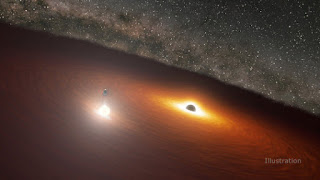 |
| Artists version from Science Daily |
 2. Comet ATLAS made the news and then fell apart and those pieces too, just as it was getting bright enough to see with the naked eye. Great picture from the Hubble
2. Comet ATLAS made the news and then fell apart and those pieces too, just as it was getting bright enough to see with the naked eye. Great picture from the Hubble 3. Comet SWAN is incoming. Just discovered two weeks ago when it burped some hydrogen, it has rapidly reached magnitude +5.5 and is just barely visible to the eye April 29th. It appears to have been bumped towards the inner solar system for the first time ever. Maybe we will all get
3. Comet SWAN is incoming. Just discovered two weeks ago when it burped some hydrogen, it has rapidly reached magnitude +5.5 and is just barely visible to the eye April 29th. It appears to have been bumped towards the inner solar system for the first time ever. Maybe we will all getto see it. Spaceweather
4. A big rock flew by today. It didn't miss by a mile. It missed by millions of miles and is only news because it is big. Named OR1998 (the year it was first identified) it is a couple kilometers wide and tumbling. You can see the list of all asteroids down to about 5 metres diameter that are coming anywhere near earth by checking the list at Spaceweather.com for updates. What's interesting is the Arecibo observatory made a radar film.
5. Is Space-Time Smooth Or Chunky?
Or is gravity particular at the smallest scale? A clever measurement has moved the decimal point over. The answer is still "apparently not". Light from a wobbly pulsar beam some ten billion light years distant was measured for energy spread. The tool they used is called ESPRESSO. The rationale:
"If space-time really is frothy and bubbling, then this should affect anything passing through space-time. For example, a beam of light going along its merry way will encounter all sorts of microscopic bumps and jostles — a Planckian gravel path rather than a smooth highway. Sometimes those little jostles will give the light a boost, nudging up its energy level, and sometimes the light will encounter a little speed bump, slowing it down. The net effect is that light traveling through a frothy space-time will slowly spread out in energy. This effect is incredibly, incredibly minute, so tiny we couldn't possibly hope to measure it in a laboratory. But thankfully, nature can provide a laboratory for us. If we can find a nice, coherent beam of light in space (in other words, a natural space laser), and that beam of light travels over billions of years to our telescopes, we can measure the spread in energy and use that to measure the frothiness of space-time." (They found it and found a cloud in front of it with iron atoms that absorbed light in a precise way.)

No comments:
Post a Comment